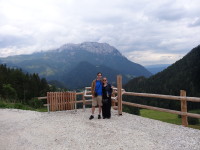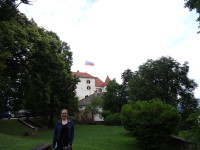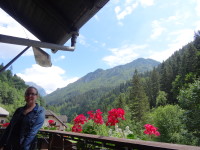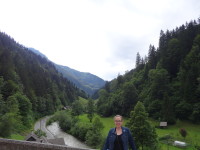 One thing you can count on for sure on a Meredith-led sightseeing tour is you will sleep well. I did not wake up at all last night, and was again surprised when the alarm went off. We wrapped up our time in Ptuj with getting ready, eating breakfast, packing, and checking out. We pointed the car west an hour, and ended up in an industrial town of forty thousand people, Velenje. We were there to see its very scenic castle, which overlooked a very concrete-rich town.
One thing you can count on for sure on a Meredith-led sightseeing tour is you will sleep well. I did not wake up at all last night, and was again surprised when the alarm went off. We wrapped up our time in Ptuj with getting ready, eating breakfast, packing, and checking out. We pointed the car west an hour, and ended up in an industrial town of forty thousand people, Velenje. We were there to see its very scenic castle, which overlooked a very concrete-rich town.
The castle looked like a proper castle, if more luxurious looking. It had a wall and towers, and you even had to enter it via a narrow footbridge. We found the reception area and bought two tickets to the castle and its eclectic collection for only five euros total (about seven dollars). This is already pretty shockingly low, but the woman who took our money then took us around the castle herself, narrating everything in solid but wonderfully, charmingly broken English. She spent almost two hours with us, all for seven bucks.
 We saw all of the collections, and we learned about the town along the way. The town was created to work the coal mines of the region, with the city begun around 1950 and officially “opened” just a few years later, having gone from a village to a small city almost overnight. The architecture was classic communist concrete apartment block, but it still was a mighty achievement.
We saw all of the collections, and we learned about the town along the way. The town was created to work the coal mines of the region, with the city begun around 1950 and officially “opened” just a few years later, having gone from a village to a small city almost overnight. The architecture was classic communist concrete apartment block, but it still was a mighty achievement.
The collections: we started with medieval Valenje, with a look at the church of the time, and how a peasant would have lived. We got distracted with asking questions, so we missed the aristocracy portion of the exhibit. We then moved on to life during Communist times, which in Yugoslavia was not so harsh as in Soviet-style Communism. We got to see several rooms of works by local painters, some of which were very moving. After that was a look at the works of an excellent local sculptor, who is now ninety and still creating art. Next was a collection of African artifacts (including a mask room where the guide started with the lights out and turned on a switch that made some of the eyes glow) that had been the collection of an artist who lived and worked in Africa for over twenty years. He died in Valenje, so his collection and some of his art went to the museum. We were then walked through a mock-up of an early twentieth-century pub and general store. Outside the main keep of the castle, we saw a chapel with artifacts from a church that was flooded by the building of a dam. There was an exhibit of mastodon bones found in the area, and a collection of high school art which was good, including a couple of excellent works. We finished the tour with a small room of WW2 memorabilia and artifacts. It was quite a tour!
 We then drove on to our destination for the next two days – Logarska Dolina. Dolina means “valley.” The Logarska region is remote and is protected as a park, so it is very rural. The mountains are the foothills of the region’s Alps, and so are very dramatic. The roads are narrow and winding, and the road was not even built until about 1900, so the region has not been touristed for very long.
We then drove on to our destination for the next two days – Logarska Dolina. Dolina means “valley.” The Logarska region is remote and is protected as a park, so it is very rural. The mountains are the foothills of the region’s Alps, and so are very dramatic. The roads are narrow and winding, and the road was not even built until about 1900, so the region has not been touristed for very long.
We set up camp at our small hotel (with a kitty!), which looks out over the mountains and has a stream running right next to it – beautiful. We drove into the small town about a mile away to visit the information center and to get lunch (lunch was a sandwich from the local supermarket). While I was waiting outside the bathroom for Meredith, I struck up a conversation with the young woman who was at the information desk. She was very friendly, and so when Meredith came out of the bathroom, we did all the things she recommended. We watched a fifteen-minute film on the region, and then she took us through a small mock-up of the area’s highlights, geography, and culture. She escorted us up the hill to another building to show us a butterfly collection and fossils found in Logarska Dolina or nearby. She was a great guide, and all of this was free. On her recommendation, we climbed a little higher to get a close look at the village church.
 We stopped in at the information center again for some dessert to fuel us for the next sightseeing jaunt – a drive along the Panoramic Road, which is a sometimes two-lane road that is sometimes paved that winds up into the alpine fields and farms. Happily, except for the first half-mile on the paved section, I never met an oncoming car over the whole eight-mile trip, which took us about two hours.
We stopped in at the information center again for some dessert to fuel us for the next sightseeing jaunt – a drive along the Panoramic Road, which is a sometimes two-lane road that is sometimes paved that winds up into the alpine fields and farms. Happily, except for the first half-mile on the paved section, I never met an oncoming car over the whole eight-mile trip, which took us about two hours.
The scenery was amazing. I kept stopping the car to get out and look and to try to take photographs that I knew would never capture the depth of the mountains. Then, we would go another half-mile, and I’d have to stop and get out again. It was cloudy and still beautiful – it must be spectacular on a sunny day. We extended our driving trip by taking an unpaved road around part of the valley. There were parts of the road that reminded me of logging roads – rough and not very wide. It was not so scenic as the Panoramic Road, but it was still worthwhile. As an aside, we took one wrong turn, which we quickly sorted out. If we had not, in just a few minutes we would have been at the Austrian border.
 We got back to the hotel around 8:00, and so we settled in for the night. We got supper in the hotel restaurant and then decided to get ready for bed. The temperature is supposed to get into the forties tonight, so we’re anticipating another sound sleep after a busy Day Four.
We got back to the hotel around 8:00, and so we settled in for the night. We got supper in the hotel restaurant and then decided to get ready for bed. The temperature is supposed to get into the forties tonight, so we’re anticipating another sound sleep after a busy Day Four.